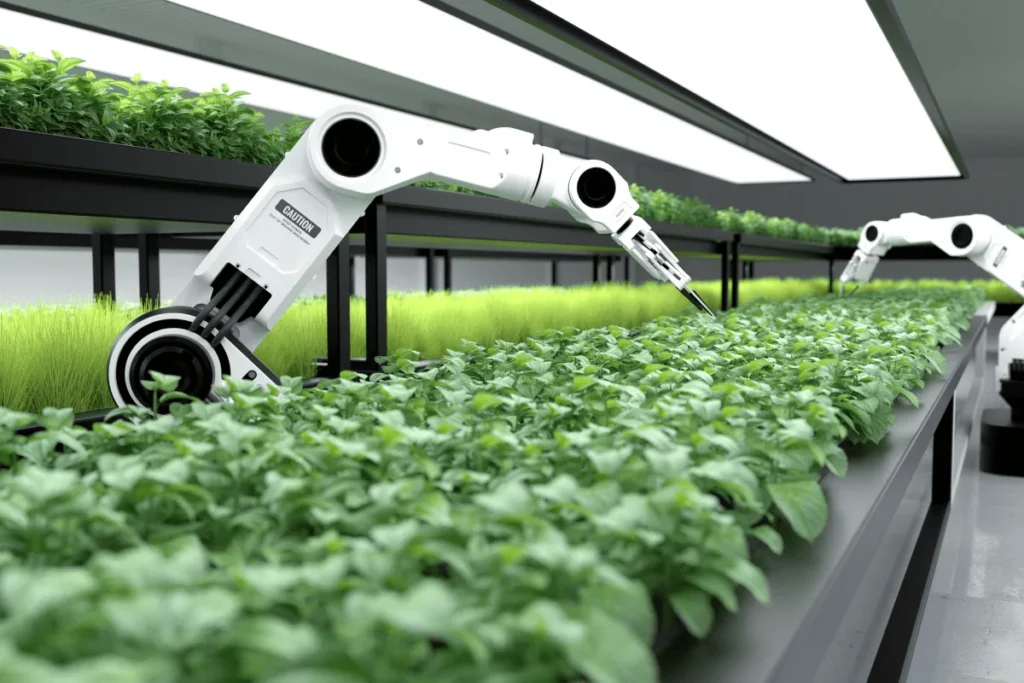The Environmental Impact of Business Automation

The Rise of Automation Over the past few decades, automation has become synonymous with progress in various industries. From manufacturing and logistics to customer service and data analysis, businesses are leveraging technologies like artificial intelligence (AI), robotics, and machine learning to automate tasks that were once performed manually. This shift highlights the significant environmental impact of business automation. Types of Business Automation Robotic Process Automation (RPA): Involves the use of software robots to execute repetitive tasks. AI and Machine Learning: Enables machines to learn from data and make intelligent decisions, reducing the need for human intervention. Internet of Things (IoT): Connects devices and systems to facilitate data exchange and automation in real-time. The Positive Environmental Impact of Business Automation Energy Efficiency: One of the key advantages of business automation is the potential for increased energy efficiency. Automated systems can optimize energy usage by monitoring and adjusting consumption based on real-time data. For instance, smart buildings equipped with automated climate control can reduce energy waste, contributing to a lower carbon footprint. Resource Optimization: Automation allows businesses to optimize resource utilization, minimizing waste and maximizing output. In manufacturing, for example, automated processes can reduce material waste and improve overall resource efficiency. This not only benefits the bottom line but also has positive implications for the environment. Sustainable Supply Chains: Automation plays a crucial role in creating sustainable supply chains. By automating logistics and inventory management, businesses can minimize transportation emissions and reduce excess inventory, leading to a more environmentally friendly operation. Green Technologies: The development and implementation of green technologies are often accelerated by automation. Businesses are investing in eco-friendly solutions powered by automation, such as smart grids, renewable energy management systems, and sustainable production processes. The Negative Environmental Impact of Business Automation Electronic Waste (e-Waste): As businesses embrace automation, the demand for electronic components and devices increases. This can lead to a surge in electronic waste, as obsolete or malfunctioning automated systems are discarded. Proper disposal and recycling of e-waste become critical to mitigate the environmental impact. Initial Carbon Footprint: The manufacturing and deployment of automation technologies contribute to an initial carbon footprint. The production of robots, AI systems, and electronic components involves energy-intensive processes, and the transportation of these technologies to their destination adds to the environmental cost. Job Displacement and Commuting: While not a direct environmental impact, the displacement of human workers due to automation can indirectly contribute to environmental issues. Job displacement may lead to increased commuting distances as workers seek employment opportunities, resulting in higher carbon emissions from transportation. Overreliance on Non-renewable Resources: Some automation technologies rely heavily on non-renewable resources, such as rare earth metals and fossil fuels. The extraction and processing of these resources can have significant environmental consequences, emphasizing the importance of sustainable practices in the development of automation technologies. Navigating the Green Frontier Sustainable Technology Development: Businesses should prioritize the development and implementation of sustainable automation technologies. This includes using eco-friendly materials in manufacturing, reducing energy consumption, and incorporating green design principles. Responsible E-Waste Management: To mitigate the negative impact of electronic waste, companies must adopt responsible e-waste management practices. This includes recycling, refurbishing, and properly disposing of obsolete automation technologies. Energy-Saving Practices: While automation can enhance energy efficiency, businesses should also implement energy-saving practices in their automated systems. This includes optimizing algorithms, using renewable energy sources, and adopting energy-efficient hardware. Workforce Transition and Training: To address the social and environmental challenges posed by job displacement, companies should invest in workforce transition programs and training initiatives. This can help employees acquire new skills and transition into roles that complement automation rather than compete with it. Regulatory Compliance: Governments and regulatory bodies play a crucial role in shaping the environmental impact of business automation. Implementing and enforcing regulations that promote sustainable practices and hold businesses accountable for their environmental footprint is essential. Conclusion The environmental impact of business automation is a complex and multifaceted issue. While automation offers significant opportunities to improve efficiency and reduce environmental impact, it also presents challenges that must be addressed to ensure a sustainable future. By adopting responsible practices, investing in green technologies, and prioritizing environmental stewardship, businesses can navigate the green frontier of automation and contribute to a more sustainable and eco-friendly world. 4o
The Evolving Landscape of Cyber Threats

The digital landscape is a constantly shifting battleground where cybercriminals employ increasingly sophisticated techniques to exploit vulnerabilities. Traditional security measures, while still valuable, are often reactive and struggle to keep pace with the speed at which threats evolve. This calls for a proactive approach, and automated security emerges as a key player in staying one step ahead of cyber adversaries. Understanding Automated Security Definition and Concepts Automated security involves the use of technology to perform tasks without direct human intervention. From routine processes to complex threat detection algorithms, automation allows for a faster and more consistent response to potential security incidents. Benefits of Automated Security Key Components of Automated Security Systems Threat Intelligence One of the cornerstones of effective automated security is up-to-date threat intelligence. By constantly monitoring global threat landscapes, automated systems can categorize and respond to potential threats with unparalleled accuracy. Incident Response Automated incident response systems streamline the process of identifying, analyzing, and mitigating security incidents. This ensures a rapid and coordinated response, minimizing the impact of a security breach. User Behavior Analytics Understanding normal user behavior is crucial in identifying anomalies that may indicate a security threat. Automation can analyze vast amounts of data to recognize patterns and deviations, triggering alerts for further investigation. Patch Management Keeping software and systems up-to-date is vital for security. Automation can handle the timely deployment of patches and updates, reducing the window of vulnerability. Real-world Applications of Automated Security Network Security Automated systems can monitor network traffic in real-time, identifying suspicious activities and preventing potential breaches. This is particularly critical as businesses increasingly rely on interconnected systems. Endpoint Security Securing individual devices is a fundamental aspect of overall security. Automation helps in the deployment of security updates, antivirus scans, and the isolation of compromised endpoints. Cloud Security As organizations migrate to the cloud, the need for robust cloud security measures becomes paramount. Automation plays a key role in ensuring the continuous monitoring and protection of cloud-based assets, addressing the unique challenges posed by the distributed nature of cloud computing. Overcoming Challenges and Concerns in Automated Security While automation brings numerous advantages, it is essential to address potential challenges and concerns associated with its implementation. The Future of Automated Security As technology continues to advance, the future of automated security looks promising. Integration with cutting-edge technologies such as artificial intelligence (AI), machine learning, and predictive analytics is on the horizon. These advancements will further enhance the ability of automated systems to adapt to emerging threats in real-time, ushering in a new era of proactive cybersecurity. Case Studies and Success Stories Examining real-world examples of organizations that have successfully implemented automated security measures provides valuable insights. From financial institutions to healthcare providers, diverse sectors have experienced tangible benefits, including reduced response times, improved threat detection, and overall strengthened security postures. Recommendations for Implementing Automated Security Implementing automated security measures requires a strategic and well-thought-out approach. Here are key recommendations: Conclusion In conclusion, automated security is a cornerstone in the ongoing battle against evolving security threats. By harnessing the power of technology, organizations can fortify their defences, respond swiftly to incidents, and stay one step ahead of cybercriminals. As we navigate an increasingly digital world, embracing automated security is not just an option but a necessity in the pursuit of robust and resilient security measures. The proactive and adaptive nature of automated security positions organizations to not only defend against current threats but also to anticipate and mitigate future challenges. The future of cybersecurity is automated, and those who embrace this paradigm will be better equipped to safeguard their digital assets in the dynamic landscape of cyberspace.
Preparing Your Team for Automation

In today’s rapidly evolving technological landscape, automation is transforming how businesses operate, challenging traditional work notions. As automation technologies advance, organizations must prepare their teams to thrive in this new era. This guide explores strategies and best practices for preparing your team for automation, equipping them with the necessary skills and mindset to navigate automation seamlessly. Understanding Automation and its Impact on the Workforce Before preparing your team for automation, it is crucial to understand what automation entails and its impact on the workforce. Automation uses technology to perform tasks previously carried out by humans. While it can streamline operations, boost efficiency, and reduce human error, it also raises concerns about job displacement and the need for upskilling. Assessing the Current Skill Set of Your Team The first step in preparing your team for automation is assessing the current skill set within your workforce. Understanding team members’ strengths and weaknesses helps identify development areas and essential skills for the automated workplace. Comprehensive skill gap analyses and performance evaluations provide valuable insights into specific areas needing improvement. Identifying Essential Skills for the Automated Workplace Certain skills have become increasingly crucial for success in an automated workplace: Digital Literacy: Proficiency in digital tools and technologies is essential for navigating automated systems. Critical Thinking: Encouraging critical thinking fosters innovation and problem-solving, enabling employees to adapt and identify improvement opportunities. Adaptability: The ability to adapt to new technologies and workflows is critical in an ever-evolving automated environment. Complex Problem Solving: Equipping your team with skills to tackle complex challenges and make data-driven decisions is essential. Implementing Continuous Learning Initiatives Establishing a culture of continuous learning is vital for preparing your team for automation challenges. Encourage participation in training programs, workshops, and online courses to help acquire new skills and stay updated on technological advancements. Providing access to learning resources and creating professional development opportunities empowers your team to adapt to changing demands. Fostering a Culture of Innovation and Collaboration In an automated environment, fostering innovation and collaboration promotes creativity and adaptability. Encourage open communication, idea-sharing, and cross-functional collaboration to facilitate diverse perspectives and ideas. Creating an environment that values experimentation and welcomes constructive feedback stimulates a sense of ownership and engagement among team members. Promoting Emotional Intelligence and Soft Skills Technical skills are essential, but emotional intelligence and soft skills are equally important. Cultivating empathy, effective communication, and interpersonal skills enhances team dynamics and promotes a positive work culture. Encouraging mindfulness practices and work-life balance contributes to overall well-being and resilience, enabling better navigation of automation challenges. Embracing Automation as an Opportunity for Growth Reframe automation as an opportunity for growth and innovation rather than a threat. Communicate the benefits of automation, such as streamlining mundane tasks, enhancing productivity, and creating new opportunities. Encouraging employees to embrace change and participate in implementing automated processes instils a sense of ownership and empowerment. Implementing Change Management Strategies Effectively managing the transition to automation requires robust change management strategies. Communicate the rationale behind adopting automation, address concerns, and provide transparent information about its impact on job roles. Involving employees in decision-making and soliciting their feedback promotes inclusivity and collaboration, ensuring a successful integration of automation. Monitoring and Evaluating the Impact of Automation Continuously monitor and evaluate the impact of automation on your workforce. Analyse key performance indicators, gather employee feedback, and assess the effectiveness of training initiatives to gain insights into your preparation strategies. Adjust your approach based on feedback and proactively address challenges to ensure sustainable growth and development. Conclusion Automation is reshaping the future of work, making it crucial to prepare your team for this transformative shift. By adopting a proactive approach to skill development, fostering continuous learning and collaboration, and viewing automation as an opportunity for growth, you can equip your team to thrive in the automated workplace. Through effective change management and ongoing monitoring, you can ensure a seamless transition and position your team for long-term success in the dynamic digital era.
